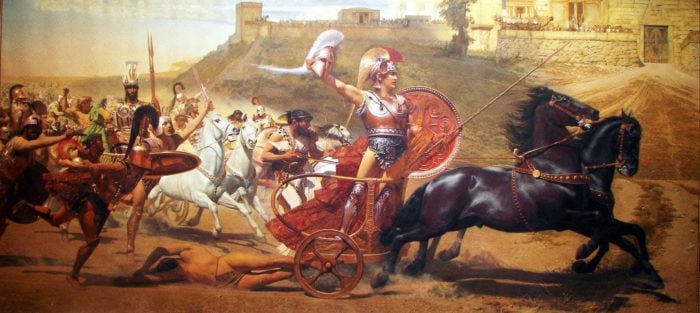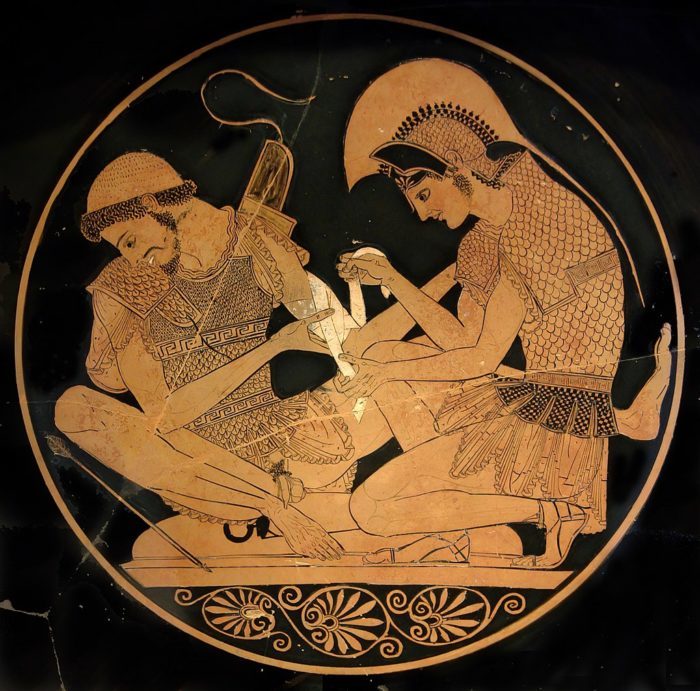
The Trojan War is so vividly described in Homer’s Iliad that it is considered by many to be historical fact and not simply the subject of an epic poem.
Troy, an ancient, wealthy city in Asia Minor was ruled by King Priam whose son Paris was invited to judge which of the goddesses—Aphrodite, Hera, or Athena—was entitled to be called the most beautiful.
Aphrodite promised Paris to grant him the most beautiful woman in the world, who was Helen, wife of Menelaus, the king of Sparta. Paris stole Helen, and they eloped to Troy.
To recover Helen, the Greeks launched a great expedition under the overall command of Menelaus’s brother, Agamemnon, the king of Mycenae.
The Greek Army under the command of the charismatic Achilles besieged Troy for ten years and finally sacked the city with the cunning use of the Trojan Horse.
The account of the Trojan War in the Iliad is an epic poem written five centuries after the supposed war; in the ensuing centuries, it has generated lengthy discourse among historians and scholars.
The question has been whether the Trojan War was real or a myth loosely based on some historical facts.
Myth and reality of Troy
In ancient Greek history, myth is often interwoven with reality, insofar as the gods interfere in the world of mortals in everyday life.
It is hard to view the Trojan War in historical terms. Some of the heroes of the war described in the Iliad are demi-gods, not mere mortals with godlike qualities.
Helen, the most beautiful woman, for instance, is the daughter of Zeus who disguised himself as a swan and raped her mother, Leda. Achilles and Paris are directly guided by the gods throughout the epic poem.
The gods also supported the two sides: Hera, Athena and Poseidon were for the Greeks, while Aphrodite, Apollo and Ares sided with the Trojans.
Then, there is the ten-year siege of Troy. At the time, at around 1200-1100 BC, even the strongest cities could only hold out for a few months, let alone a decade.
Recent excavations have shown that ancient Troy truly was a significant Bronze Age city dating back to the 12th century BC.
The charred debris and scattered skeletons are evidence that the city was destroyed during wartime. Most likely, Homer used the destroyed city as the setting for his epic poem.
Barry Strauss, a professor of History and Classics at Cornell University, and author of The Trojan War: A New History questions the original Troy myth.
Specifically, Strauss questioned whether the ruined city was the splendid city described by Homer, whether it was the setting for the Trojan War, and if the Greeks actually besieged the city.
New excavations since 1988 have proved that Troy did exist and was indeed a large city, about 75 acres in size, surrounded by fields of wheat. Furthermore, they provided evidence that in 1200 BC the city was in its heyday.
There is more evidence of the above coming from Hittite texts. In these documents, the city that Homer calls Troy, or Ilion, is referred to as Taruisa or Wilusa, and in the early form of the Greek language, “Ilion” was rendered as “Wilion.”

Were the Trojans Greeks?
Earlier scholars thought that the Trojans were Greeks, like the men who laid siege to their city. The names of Patroclus, Hector, Helen and others in the Iliad is suggestive of this.
However, new evidence suggests that the urban plan of Troy looks less like that of a Greek city and more like an Anatolian city.
Troy’s combination of citadel and lower town, its house and wall architecture, and its religious and burial practices are all typically Anatolian. So is much of its discovered pottery.
Also, new documents suggest that most Trojans spoke a language closely related to Hittite and that Troy was a Hittite ally. And the Hittites were enemies of the Greeks.
The Greeks wanted to expand their territory, and as a people surrounded by water, they built some of history’s first warships.
They explored the land across the Aegean looking for new territories, either as merchants or as potential conquerors.
Around 1400 BC, they conquered Crete, the home of the Minoan civilization. They also conquered the southwestern Aegean islands and the city of Miletus on the coast of Anatolia.
In the 13th century, they stirred up a rebellion against the Hittites of western Anatolia. In the 12th century, they took over the islands of the northeastern Aegean across from Troy.
In the 11th century, they joined with the “Sea Peoples,” who descended first on Cyprus and then on the Levant and Egypt, finally settling in the Philistine country, today’s coastal Israel.
According to Strauss, the Trojan War probably took place sometime between 1230 and 1180 BC, more likely between 1210 and 1180.
At that latter date, the city of Troy was destroyed by a raging fire. The findings of arrowheads, spearheads, and sling stones—along with unburied human bones—suggest that the city was sacked with great violence.
Moreover, the towns around Troy seem to have been abandoned around 1200 BC, consistent with an invasion, as recent archaeological findings indicate.
Further indications about the importance of Troy are the exploration of the site by later ancient figures, such as Alexander the Great and the Roman Emperor Augustus.
The citadel was also enlarged later for the erection of Greek and Roman temples, a process that tragically destroyed layers of Bronze Age remains. The destruction was continued in later centuries by tourists and looters.
Strauss also argues against historians who claim that since great ancient Greek palaces like Mycenae and Pylos were destroyed around 1180 BC, how could the Greeks attack Troy between 1210 and 1180?
The professor counterargues that history is full of sudden reversals. Furthermore, the Trojan War was followed by wars and chaos in the Greek homeland.
Was the Trojan War real?
University of Queensland researcher Trevor Bryce in his book The Trojans and their Neighbours (Routledge, 2006) tries to address the question about whether or not there really was a Troy and a Trojan War.
The topography of the city as told in the legend matches that of a real-life city, and people at Homer’s time also believed this to be Troy.
Certain archaeologists argue that the city was destroyed by earthquakes at the time of the Trojan War and later may have received people from southeastern Europe rather than Greece.
“At one end of the spectrum of opinion is the conviction that there was indeed a war and that it was pretty much as the poet described it,” Bryce wrote.
“From that we pass through varying degrees of [skepticism] and agnosticism to the other end of the spectrum where the tradition is consigned wholly to the realm of fantasy,” Bryce added.
The ancient Greeks needed Trojan War to be real
For author, classist, and critic Daisy Dunn, Homer’s Iliad was a vivid account of a real war because Greeks of the time needed it to be so. In the grim world they lived in, they needed to escape into a world of heroes and great deeds.
Dunn wrote on BBC.com (Culture):
The Greeks found in the legacy of the Trojan War an explanation for the bloody and inferior world in which they lived. Achilles and Odysseus had inhabited an age of heroes.
Their age had now died, leaving behind it all the bloodthirstiness, but none of the heroism or martial excellence of the Trojan War. Even the immediate aftermath of the war was full of violence.
Whether the Trojan War really happened or not is a moot point thirty-three centuries later. What is important is that the legend of the brave Greeks who besieged Troy and conquered it by using the Trojan Horse inspired generation upon generation, as does Homer’s Iliad, which remains one of the greatest works of world literature and a masterpiece of our intangible cultural heritage.
See all the latest news from Greece and the world at Greekreporter.com. Contact our newsroom to report an update or send your story, photos and videos. Follow GR on Google News and subscribe here to our daily email!



